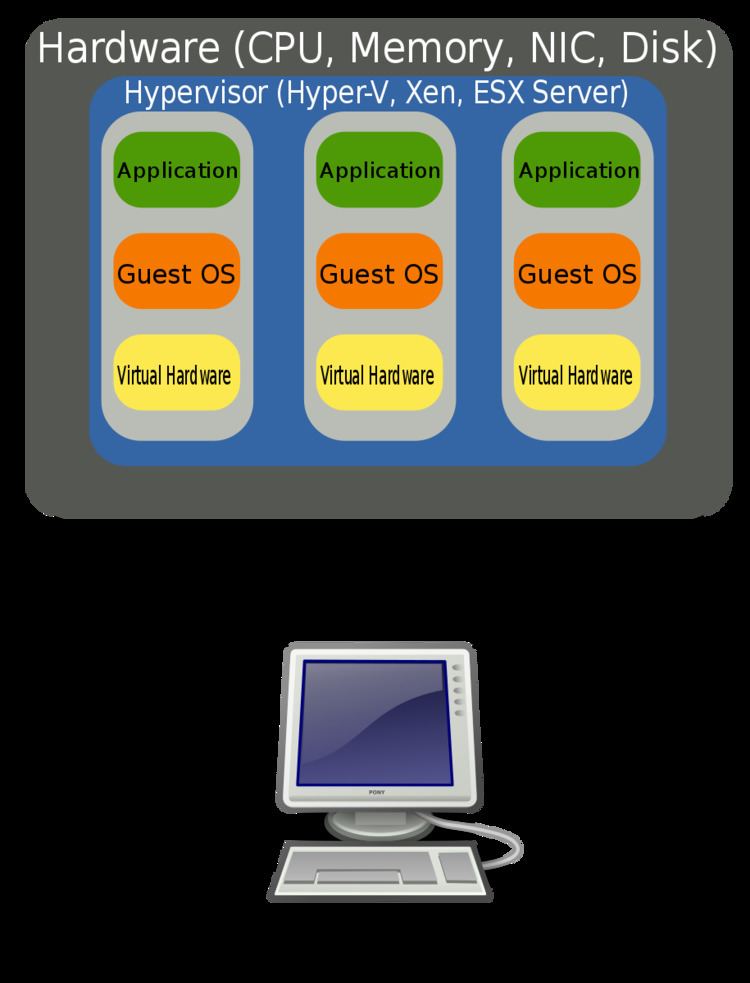 | ||
Computer hardware virtualization is the virtualization of computers as complete hardware platforms, certain logical abstractions of their componentry, or only the functionality required to run various operating systems. Virtualization hides the physical characteristics of a computing platform from the users, presenting instead another abstract computing platform. At its origins, the software that controlled virtualization was called a "control program", but the terms "hypervisor" or "virtual machine monitor" became preferred over time.
Contents
Concept
The term "virtualization" was coined in the 1960s to refer to a virtual machine (sometimes called "pseudo machine"), a term which itself dates from the experimental IBM M44/44X system. The creation and management of virtual machines has been called "platform virtualization", or "server virtualization", more recently.
Platform virtualization is performed on a given hardware platform by host software (a control program), which creates a simulated computer environment, a virtual machine (VM), for its guest software. The guest software is not limited to user applications; many hosts allow the execution of complete operating systems. The guest software executes as if it were running directly on the physical hardware, with several notable caveats. Access to physical system resources (such as the network access, display, keyboard, and disk storage) is generally managed at a more restrictive level than the host processor and system-memory. Guests are often restricted from accessing specific peripheral devices, or may be limited to a subset of the device's native capabilities, depending on the hardware access policy implemented by the virtualization host.
Virtualization often exacts performance penalties, both in resources required to run the hypervisor, and as well as in reduced performance on the virtual machine compared to running native on the physical machine.
Reasons for virtualization
However, when multiple VMs are concurrently running on the same physical host, each VM may exhibit a varying and unstable performance, which highly depends on the workload imposed on the system by other VMs, unless proper techniques are used for temporal isolation among virtual machines.
There are several approaches to platform virtualization.
Examples of virtualization scenarios:
Full virtualization
In full virtualization, the virtual machine simulates enough hardware to allow an unmodified "guest" OS (one designed for the same instruction set) to be run in isolation. This approach was pioneered in 1966 with the IBM CP-40 and CP-67, predecessors of the VM family.
Examples outside the mainframe field include Parallels Workstation, Parallels Desktop for Mac, VirtualBox, Virtual Iron, Oracle VM, Virtual PC, Virtual Server, Hyper-V, VMware Workstation, VMware Server (discontinued, formerly called GSX Server), VMware ESXi, QEMU, Adeos, Mac-on-Linux, Win4BSD, Win4Lin Pro, and Egenera vBlade technology.
Hardware-assisted virtualization
In hardware-assisted virtualization, the hardware provides architectural support that facilitates building a virtual machine monitor and allows guest OSes to be run in isolation. Hardware-assisted virtualization was first introduced on the IBM System/370 in 1972, for use with VM/370, the first virtual machine operating system.
In 2005 and 2006, Intel and AMD provided additional hardware to support virtualization. Sun Microsystems (now Oracle Corporation) added similar features in their UltraSPARC T-Series processors in 2005. Examples of virtualization platforms adapted to such hardware include KVM, VMware Workstation, VMware Fusion, Hyper-V, Windows Virtual PC, Xen, Parallels Desktop for Mac, Oracle VM Server for SPARC, VirtualBox and Parallels Workstation.
In 2006, first-generation 32- and 64-bit x86 hardware support was found to rarely offer performance advantages over software virtualization.
Paravirtualization
In paravirtualization, the virtual machine does not necessarily simulate hardware, but instead (or in addition) offers a special API that can only be used by modifying the "guest" OS. For this to be possible, the "guest" OS's source code must be available. If the source code is available, it is sufficient to replace sensitive instructions with calls to VMM APIs (e.g.: "cli" with "vm_handle_cli()"), then re-compile the OS and use the new binaries. This system call to the hypervisor is called a "hypercall" in TRANGO and Xen; it is implemented via a DIAG ("diagnose") hardware instruction in IBM's CMS under VM (which was the origin of the term hypervisor). Examples include IBM's LPARs, Win4Lin 9x, Sun's Logical Domains, z/VM, and TRANGO.
Operating-system-level virtualization
In operating-system-level virtualization, a physical server is virtualized at the operating system level, enabling multiple isolated and secure virtualized servers to run on a single physical server. The "guest" operating system environments share the same running instance of the operating system as the host system. Thus, the same operating system kernel is also used to implement the "guest" environments, and applications running in a given "guest" environment view it as a stand-alone system. The pioneer implementation was FreeBSD jails; other examples include Docker, Solaris Containers, OpenVZ, Linux-VServer, LXC, AIX Workload Partitions, Parallels Virtuozzo Containers, and iCore Virtual Accounts.
Hardware virtualization disaster recovery
A disaster recovery (DR) plan is good business practice for a hardware virtualization platform solution. DR of a virtualization environment can ensure high rate of availability during a wide range of situations that disrupt normal business operations. Continued operations of VMs is mission critical and a DR can compensate for concerns of hardware performance and maintenance requirements. A hardware virtualization DR environment involves hardware and software protection solutions based on business continuity needs, which include the methods described below.
